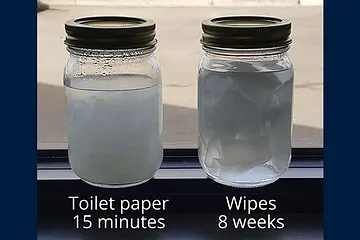Blog
One of the most common questions I receive is “how often should I have my main line cleaned out?”. Well, the answer to that question is not cut and paste. Multiple factors go into determining a time frame. To narrow it down, the three main factors are: what type of abuse is the main receiving, condition of the pipe and how many people are in the household?
What type of Abuse?
When it comes to abuse, I’m speaking about what is going down the drains. Putting items such as wipes, feminine hygiene products, grease and/or food will eventually build up to a clog. Wipes are packaged in moisture and therefore do not break down in water like toilet paper does. Food and grease will build up over time and combined with other solid waste will turn into a sludge substance that does not like to move.
What’s the Condition of Pipes?
The materials your pipes are made of have a shelf life. If your house was built before the 80’s and hasn’t been remodeled or updated, then your plumbing will be most likely cast iron inside the home and clay outside the home. Clay pipes can easily be penetrated by roots over the years. Getting in at the joints or small cracks in the pipe itself.
Cast iron pipes can get badly scaled, which is rust on the inside of the pipe. This scale will slow down and restrict the flow of the pipe causing build up. I wish I could say the condition of the pipe is only limited to older systems but even the newer homes with PVC can have issues. Main issue I’ve come across with newer homes is improper flow. Water flows downhill and if your pipes don’t then the sewage will slow down and clog eventually.


How Many People are in the Household?
This variable is pretty cut and paste. A single person household is going to use the plumbing system a lot less than what a six-person household will. That’s more food and grease down the drain. More toilet paper and possibly wipes.
So, to answer the question of how often a main line should be cleaned out, it’s hard to determine that. On average, with what I’ve seen with my customers is every two years they start to have issues with their sewer line. Roots will take approximately two years to infiltrate and become a problem. Of course, there is always ways to prolong a clog.
Root killers like RootX that you can flush down will keep roots from becoming an issue. Natural enzyme drain cleaners that you treat your drains with will help keep organic waste from building up. But mainly, if you can throw it away instead of flushing it down the drain then that is the best method to prolonging any clog! Anything solid is a potential clog!
These programs have a wide range of coverage depending on what municipality or county you are in. Most cover 75-100% of the costs from $3000 to up wards of $15,000 in some municipalities. If your property taxes are paid up, you can apply for this coverage. The parameters of these programs also vary, but most will cover any broken line outside the house or excess amounts of roots that must be cleared more than once a year. You will need to show receipts for proof. Unincorporated St. Louis County does require a Master Plumber to sign and submit the application, but the other programs do not require that. A quick internet search of your city’s sewer lateral program will tell you everything you need to know to get started. Take advantage of these programs. Your home and your wallet will thank you!
